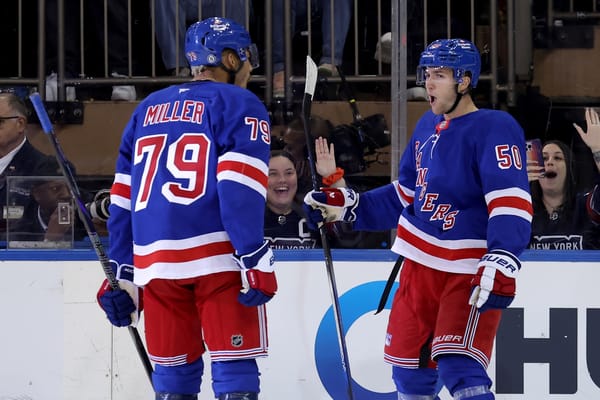Bridging Mika Zibanejad Would Be A Huge Mistake
If history is any indication, Glen Sather never really learned his lesson. For every moment of shrewd, savvy business (the Ryan Callahan trade for example), there were two or more moments of insanity (the Dan Girardi extension and the Marc Staal extension immediately come to mind).
For the moment, we’re seeing a pretty big difference in the way Jeff Gorton is running the ship. He moved Derek Stepan, at least in part, due to future financial flexibility. He bought out Girardi this summer for the same reason. He locked down Jesper Fast to a very team-friendly contract, and the work done with Kevin Shattenkirk is nothing short of brilliant beyond words. The only place you can claim Gorton “overstepped” was the Brendan Smith contract, and even that was an over payment in the hundreds of thousands, not anywhere near millions.
Every move seems to be made with the intent of the Rangers keeping their future finances open rather than locked up. Kevin Klein’s retirement helped quite a bit –although it would be unfair to give Gorton credit for that. And Gorton’s work with the defense may not be complete this offseason, as there are rumors swirling that Nick Holden is on the trade block, although it remains to be seen if he will be moved. Unless Gorton intends to trade Staal, which is unlikely, moving Holden makes sense with the current status of the defense.
Right now the only thing we’re still waiting on is a Mika Zibanejad extension. Zibanejad filed for arbitration already, which is a very normal step in RFA negotiations. Filing for arbitration should not be blown out of proportion, as it’s just an RFA using what little leverage they have.
There has been very little information leaked about the current negotiations – outside of the fact that Zibanejad fired his agent to allow his half-brother to handle the negotiations (this is something odd for what it’s worth). Larry Brooks suggested the Rangers might want to avoid a “show me” deal, which I agree with wholeheartedly.
If the Rangers are truly wary about their future financial opportunities, they need to start by taking calculated risks with key free agents. Zibanejad is a critical part of the Rangers’ future (here’s his report card for what it’s worth) and his ceiling is as high as you’d like to see from a 24-year-old. He’s also in a prime place for the team to “bridge” him, which means signing him to a two-year deal for less money with the promise of more money down the line.
This is a tactic the Rangers utilized for all RFAs under Sather – as Brandon Dubinsky, Marc Staal, Derek Stepan, Dan Girardi, Artem Anisimov, Henrik Lundqvist (via arbitration), Chris Kreider, Michael Del Zotto, and Mats Zuccarello are all names of players who have received this treatment. Most recently, Oscar Lindberg, Fast, Kevin Hayes, and J.T. Miller have seen much of the same. In some instances, the precedent works, while it creates a ticking time bomb for others.
Miller and Hayes are perfect examples of players who would have saved the Rangers money down the line had the team taken a longer approach with them after their ELCs expired. Miller specifically is going to cost the Rangers at least a couple of million dollars more than he probably could have been tagged for last year (more on that here). Notably, only Ryan McDonagh avoided the forced bridge deal, and that has turned out to be the Rangers best contract.
Zibanejad is coming off a 37-point campaign in 56 games. Even factoring out his the mid-season injury that cost him some of his mojo, he still finished the year at a 54-point pace. Before he got hurt and his line mates were taken away, Zibanejad was part of the hottest line in hockey with Pavel Buchnevich and Chris Kreider. Then in the playoffs, he might have been the Rangers best forward offensively.
Assuming Zibanejad won’t continue to grow is foolish and if the Rangers bridge him at (say) $3.5-million only to find a 65+ point player in two years, they’re going to once again handcuff themselves to needing to shell out far more money tomorrow than they would have had to today – on a long-term contract that would likely run past his prime. (We talked about this on the podcast last week, which you should subscribe to, give five stars, and leave a nice comment about. Or even donate on the Patreon if you can.)
There is a fair amount of evidence that (at the very worst) Zibanejad is a 50-point player who can handle himself in his own zone. His shot can be devastatingly lethal when it’s on target, and his vision is something every team would love to have. For a guy who won’t turn 25 until April, there’s so much to love about him and so few drawbacks. In his 337 games in the NHL he has accumulated 188 points that has averaged into 0.56 points per game (which is a 46-point average per 82 games). That includes his first two professional years where he only accumulated 53 points in 111 games.
A “show me” deal (or a bridge deal) makes sense when you have a player who is expected to do good things but really hasn’t delivered yet. Kreider is a good example of someone who didn’t cost the Rangers all that much more because of a bridge deal. Miller will more than likely be a player who will prove the Rangers should have locked him up cheaper when they had the opportunity to earlier.
Learning this lesson with Miller would help the Rangers a lot here. Inking Zibanejad to a five or six year deal in the $4.5-million neighborhood would be exactly what the doctor ordered. For Zibanejad, it would guarantee him substantial money right now and allow him to become a UFA at 29, when he still would be able to sign another long-term contract. On the team side, it would ensure the Rangers have a key player locked up for the foreseeable future.
To bridge him would be repeating past mistakes.
Glen Sather was bad at learning those lessons.
Let’s hope Jeff Gorton isn’t.





